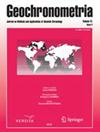湖泊沉积物源物质中不同钾长石pIRIR信号的白化——以中亚干旱区博斯腾湖盆地为例
IF 0.9
4区 地球科学
Q3 Earth and Planetary Sciences
引用次数: 0
摘要
摘要对中亚干旱天山南部博斯腾湖盆地多种现代沉积物源的k长石ir后IRSL (pIRIR)信号(pIR50IR170、pIR50IR290和pIR200IR290)的残留年龄和漂白进行了评估,以确定最适合样品的相,以确定与第四纪古湖泊发育相关的良好漂白沉积年龄。结果表明,pIR50IR290的雨积扇、河流和风积沉积物群的残留年龄分别为40-6 ka、6-3 ka和2-1 ka,为沉积年龄。pIR200IR290信号的残差年龄是pIR50IR290信号的两倍,而pIR50IR170信号的残差年龄与pIR50IR290信号的残差年龄相似。风成和河流样品显示漂白程度较高的粗粒(90 ~ 125 μm)钾长石和漂白程度较低的粗粒钾长石。河流和洪积样品中的高残留剂量表明,利用不同的pIRIR信号对全新世湖泊样品应用pIRIR定年可能不可取。然而,风成沉积的残余年龄测量很小,可以通过针对全新世样品的k长石pIR50IR170信号和更新世样品的pIR200IR290和pIR50IR290信号来精确和可靠地评估古湖泊的发育。本文章由计算机程序翻译,如有差异,请以英文原文为准。
The Bleaching of Different K-Feldspar pIRIR Signals of Source Materials of Lacustrine Sediment – A Case Study from Bosten Lake Basin in Arid Central Asia
Abstract The residual ages and bleaching of K-feldspar post-IR IRSL (pIRIR) signals (pIR50IR170, pIR50IR290, and pIR200IR290) for a variety of modern sediment sources to the Bosten Lake basin in the southern Tian Shan of arid central Asia were assessed to identify the most appropriate facies to sample for ascertaining well-bleached, depositional ages associated with Quaternary paleolake development. Results indicate pIR50IR290 residual ages for pluvial fan, fluvial, and eolian sediments cluster at 40–6, 6–3, and 2–1 ka, respectively, and are depositional ages. Residual ages of pIR200IR290 signals are twice that of pIR50IR290 signals, while residual ages of pIR50IR170 signals are similar to that of pIR50IR290 signals for all samples. Eolian and fluvial samples show well-bleached, coarse-grained (90–125 μm) K-feldspar and poorly-bleached coarse grained K-feldspar from pluvial samples. High residual doses in fluvial and pluvial samples indicate it may not be advisable to apply pIRIR dating utilising different pIRIR signals to Holocene lacustrine samples. However, the residual ages measured for eolian deposits are small and can allow precise and robust assessment of paleolake development by targeting the K-feldspar pIR50IR170 signal to date Holocene samples and the pIR200IR290 and pIR50IR290 signals to date Pleistocene samples.
求助全文
通过发布文献求助,成功后即可免费获取论文全文。
去求助
来源期刊

Geochronometria
地学-地球科学综合
CiteScore
2.20
自引率
0.00%
发文量
1
审稿时长
>12 weeks
期刊介绍:
Geochronometria is aimed at integrating scientists developing different methods of absolute chronology and using them in different fields of earth and other natural sciences and archaeology. The methods in use are e.g. radiocarbon, stable isotopes, isotopes of natural decay series, optically stimulated luminescence, thermoluminescence, EPR/ESR, dendrochronology, varve chronology. The journal publishes papers that are devoted to developing the dating methods as well as studies concentrating on their applications in geology, palaeoclimatology, palaeobiology, palaeohydrology, geocgraphy and archaeology etc.
 求助内容:
求助内容: 应助结果提醒方式:
应助结果提醒方式:


